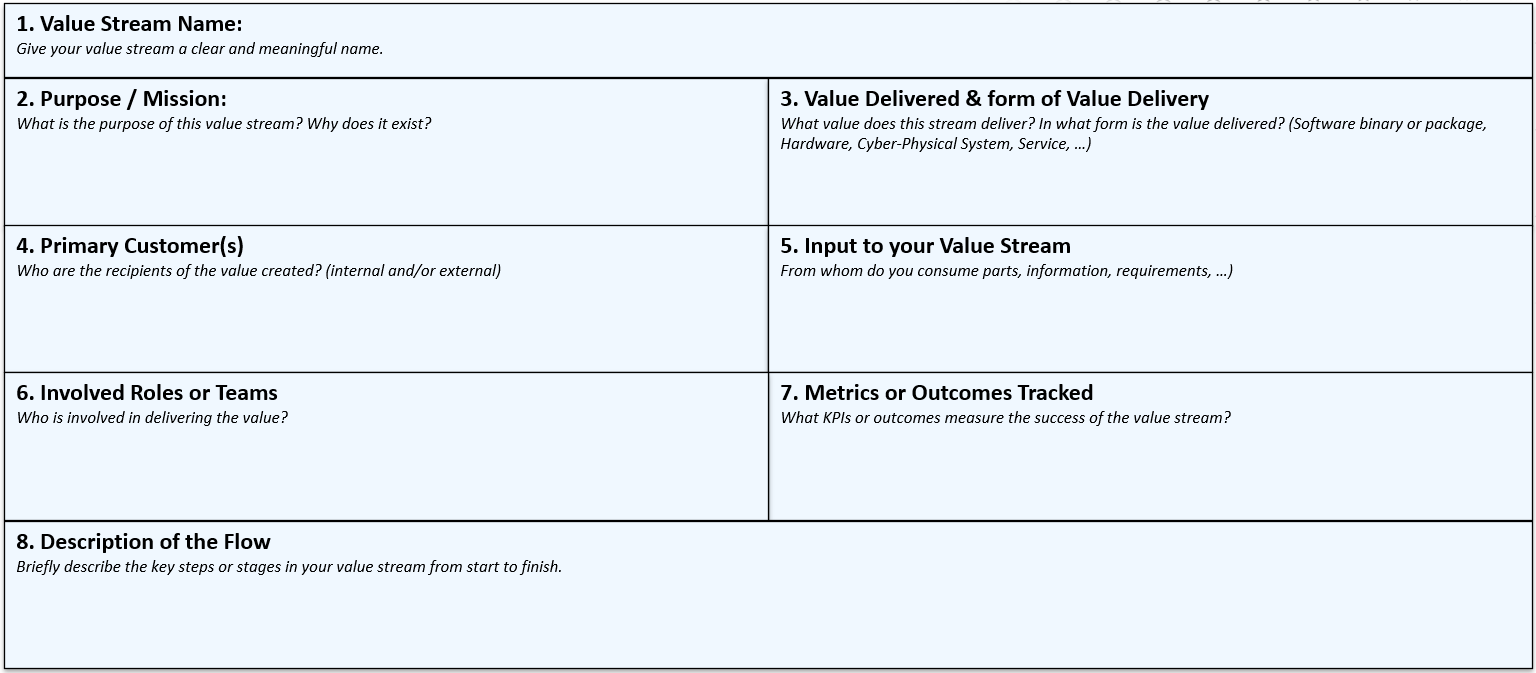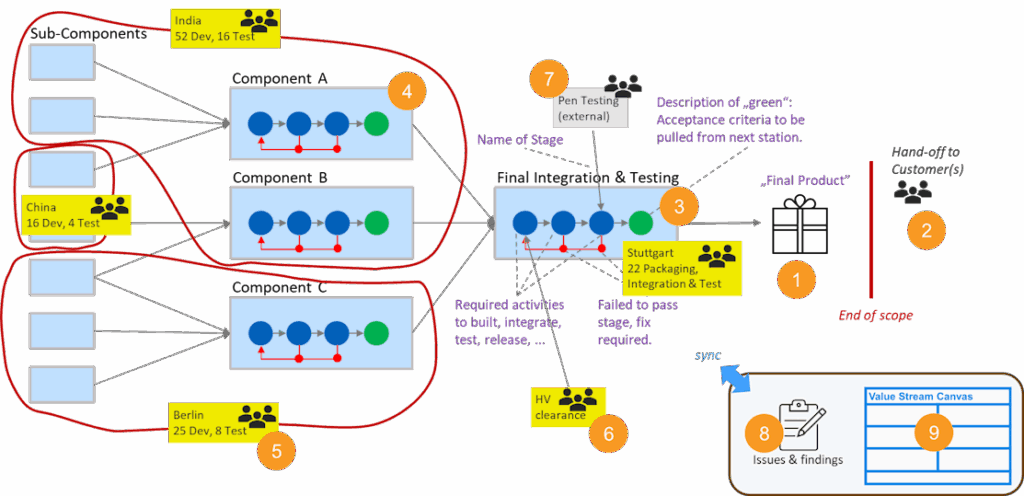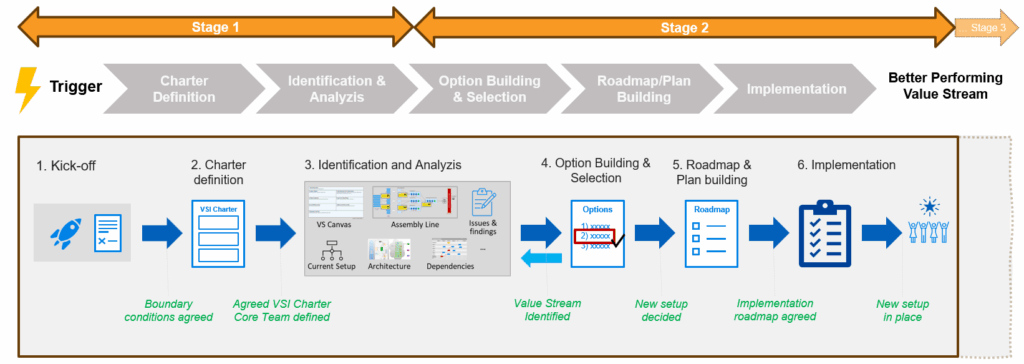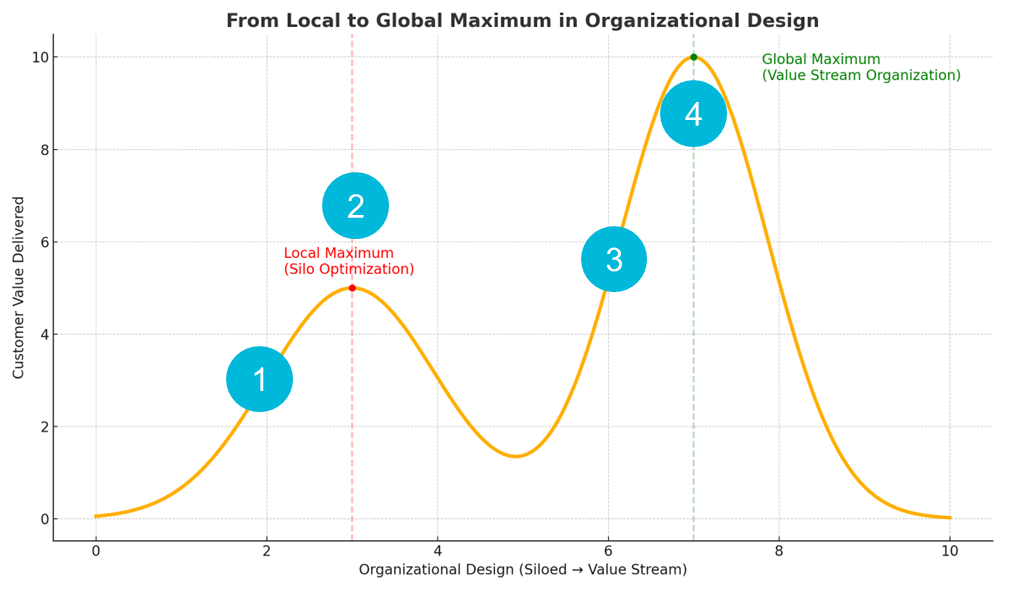Value Stream Identification
This article introduces the concept of Value Stream Identification (VSI) and explains how it helps organizations gain clarity about how value is delivered. It outlines practical tools like the Value Stream Canvas and the Assembly Line Model, and emphasizes why simply visualizing a value stream is not enough.
„When you improve a system, start by making the work visible.“ – Gene Kim
Describing a Value Stream
As already discussed in the article Why Value Stream Thinking, it is essential to define what a value stream actually is and ensure a shared understanding among stakeholders before attempting to identify them.

A value stream is the end-to-end sequence of activities required to deliver value to a customer – spanning concept, creation, and delivery. It includes the people, processes, information, and tools essential to creating, integrating, and delivering that value. These streams exist in every organization, but they’re rarely visible or well understood.2
The above definition and common conceptual representations give an initial sense of what a value stream is, but they don’t provide enough guidance for practical identification.
Value Stream Identification
To move from abstract understanding to practical application, we will first clarify what Value Stream Identification involves, and then outline which information and representations are most suitable for identifying a value stream effectively.
Value Stream Identification (VSI) is the structured process of discovering, defining, and scoping value streams within an organization. It clarifies:
• What products, services, or capabilities are delivered
• Who the customers are
• How value flows from idea to realization
The identification normally also includes a new setup that is organized around value as starting point for a successful further optimization.
Discovering means exploring where value is currently being delivered, moving beyond organizational charts to uncover the real flows of work and value.
Scoping means selecting a meaningful slice of work – big enough to deliver recognizable value, yet small enough to model, discuss, and improve effectively. These slices, called Value Streams, together form the bigger Value Stream or Value Stream Landscape.
Defining is done with the Value Stream Canvas, which makes the stream explicit by capturing its purpose, customers, and end-to-end activities in a concise, structured way.
The purpose of a VSI is to provides the necessary understanding of the current value stream as the foundation for:
- Organizing around value to
- Reduce lead time, and to maximize flow, quality and productivity (effectiveness and efficiency)
- Building the Value Stream Landscape in larger contexts
The major outcomes of a VSI are:
- Value Stream Canvas: capture major attributes of the value stream (one page description)
- Assembly Line Model: visualize the flow of work and the people involved
- Issues & Findings List: identify strengths, weaknesses, and opportunities for improvement
The Value Stream Canvas
A practical way to describe a value stream is through the Value Stream Canvas. Like any canvas, its purpose is to present a clear, concise, and structured view – in this case, of the development value stream. It captures the essential elements in a format that fosters alignment, improves communication, and enables actionable insights.

The Assembly Line
The Assembly Line is a visual model of the value stream that shows its flow, value creation, and key roles across all stages, including handoffs to the customer. It extends the canvas, provides the basis for the Issues and Findings List, and serves as the central model for systematic, continuous improvement throughout the value stream’s lifecycle. The process of creating an Assembly Line is described in the article Using the Assembly Line Approach for Value Stream Identification.

The Issues & Findings List
To fully understand a value stream, it is important to capture not only its strengths but also its current issues, as these insights shape the urgency to re-setup and optimize. During Value Stream Identification activities, such issues and observations inevitably surface. To keep the identification process focused, they are documented in a structured Issues and Findings Table rather than discussed at length on the spot. Each entry records the issue or finding, its scope, the area of the Assembly Line where it occurs, the impact in terms of flow, lead time, productivity, or quality, and the relevant expert or contact. This approach ensures that valuable insights are not lost, while avoiding premature problem-solving or side discussions. The table is refined over time and becomes a key input for future-state proposals, where setup options are assessed against their ability to address the identified issues.
The Value Stream Identification Process
The quality of a Value Stream Identification outcome depends greatly on the process used. We recommend the following process for conducting an effective and efficient identification. The end-to-end steps are outlined in the article How to Start – Single Value Stream, and for orientation the process diagram is shown below.

We believe our approach offers distinct advantages compared to traditional methods: it achieves results faster, is easier to run, and, in our experience, is far more likely to get it right. By starting simple and adding detail only when needed, it avoids unnecessary complexity. The approach scales naturally from a single stream to enterprise-wide landscapes, embraces the iterative nature of product development, minimizes participant effort through focused sessions, and generates outcome-based insights that enable systematic, continuous improvement.
Value Stream Identification should be complemented with „Organizing around Value“
After creating the Value Stream Canvas, the Assembly Line Model, and the Issue List, we gain a strong understanding of the current state of the value stream – and could, at first glance, consider the VSI complete. However, these insights alone don’t lead to improvement. To create real impact, the next logical step is to envision a future state: a redesigned value stream that addresses key issues and enables more effective value delivery.
That’s why we typically view Value Stream Identification (VSI) not just as an analysis activity, but as the first step toward reorganizing around value. In larger organizations, it may be appropriate to pause at this point – using the results to prioritize which value streams to address first. Given limited resources, improvements must often be sequenced strategically, based on business impact, urgency, and readiness for change.
There are various ways to improve a value stream – ranging from continuous improvement through targeted Kaizen bursts, to defining a future state, or even envisioning an ideal state1. Choosing the right approach is critical, as it determines the degree of achievable performance and improvement. We recommend the following stages:
Stage 1: Value Stream Identification
Begin by developing a high-level understanding of the value stream to gain clarity on its current state. This involves identifying key attributes using tools such as the Valu
Stage 2: Initial setup of the Value Stream: Organize around Value
Simply identifying a value stream does not create impact on its own. To realize benefits, the identification is typically followed by a new, improved setup – guided by the principle of organizing around value. This may include structural or team changes that better align with the value stream’s flow.
Stage 3: Continuous, systematic improvement of the Value Stream: Value Stream Optimization
Once the structure is in place, the focus shifts to continuous optimization – both of the value stream itself and of the methods used to measure its performance. Improving only the existing structure risks achieving only a local optimum. A broader perspective enables movement toward a global optimum.
Only the first two stages fall within the scope of Value Stream Identification (VSI); the third stage is part of Value Stream Optimization (VSO), which focuses on systematically and continuously improving value stream performance and enhancing the ability to measure it effectively.
Global versus Local Optimum – The Importance of Stage 2
„Some changes, by their very nature, cannot be incremental.
They need the introduction of a fundamental change – a break with the past.„2
– James Martin
We include organizing around value as part of the Value Stream Identification (VSI) activity for a simple reason: it unlocks significant improvement potential.
To illustrate this, consider the difference between two improvement strategies:

Continuous improvement focuses on making incremental gains within the boundaries of the existing system. These efforts, while valuable, are constrained by the current organizational structure and its inherent limitations.
Organizing around value, on the other hand, is a transformative step. It involves realigning teams, responsibilities, and workflows to reflect the actual flow of value. This structural change lays a far stronger foundation for meaningful, sustainable improvement.
By embedding this reorganization step into the identification phase, we do more than describe the value stream – we begin to actively shape it for better performance outcomes.
Let’s visualize this idea:
The local maximum (point 2, in red) represents the best performance achievable through continuous improvement within the current setup (point 1).
However, if we first organize around value, we move to a fundamentally better starting point (point 3). From there, we can pursue targeted optimization to reach a global maximum (point 4, in green), where value stream performance is significantly higher and more sustainable.
In short:
(3 → 4): Full potential unlocked through targeted optimization
(1 → 2): Limited gains within existing constraints
(1 → 3): Structural shift through organizing around value
Conclusions
Value Stream Identification (VSI) provides a structured way to visualize and describe how value flows through an organization. Using tools like the Value Stream Canvas, the Assembly Line Model, and an Issue List, teams gain a clear, shared understanding of the current state – its boundaries, key roles, delivery mechanisms, and challenges. This visibility creates alignment and lays the groundwork for informed decision-making.
However, visibility alone does not lead to improvement. To unlock meaningful and sustainable gains, organizations must take the next step: organizing around value. This structural shift removes existing constraints and creates the conditions necessary for reaching maximum performance.
References
- See e.g. Chapter 8 in Pereira, Steve; Davis, Andrew. Flow Engineering: From Value Stream Mapping to Effective Action (English Edition) (S.129). IT Revolution Press. Kindle-Version. ↩︎
- Martin, J. (1995). The Great Transition: Using the Seven Disciplines of Enterprise Engineering to Align People, Technology, and Strategy. AMACOM.
James Martin came to a similar conclusion nearly 30 years ago. In Chapter 18, “TQM vs. Revolution,” he explores the pros and cons of continuous improvement versus fundamental redesign – emphasizing that, in some cases, breakthrough change must come first, before incremental improvements can be effective. We advocate a similar approach today: first organize around value, then begin optimizing the redesigned system. ↩︎
Author: Peter Vollmer – Last Updated on November 3, 2025 by Peter Vollmer
